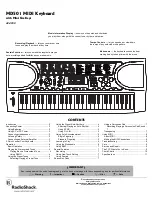
Changes from the original CX-3 9–1: AMS Mixer
233
Changes from the original CX-3
With the OASYS CX-3, Korg has taken the original,
ground-breaking CX-3 model and made it even better.
If you’d like to convert sounds from the original CX-3,
the following notes describe these changes in detail.
Noise Level range improved
The Noise Level parameter now offers more fine
control over the most useful range of values. When
converting CX-3 voicing, multiply the CX-3 Noise
Level by 10.
EX Mode enhanced
On the original CX-3, there were four global settings
for the EX Mode drawbar frequencies. The OASYS CX-
3 offers four global presets, which match the factory
defaults of the original CX-3, and then also allows you
to set different frequencies for each Program if desired.
The range of the EX drawbar pitches has also been
extended to go all the way down to 16’, in semitone
steps.
Finally, the CX-3 supports keyboard splits with full EX
drawbars on both upper and lower sides of the split.
Split Transpose increased
You can now transpose both sides of the split up or
down by up to two octaves, for more flexible zoning on
76- and 88-key instruments.
Expression parameters per-Program
The expression-related parameters can be set
separately for each Program.
Percussion for either lower or upper drawbars
The percussion can be assigned to either the lower or
upper drawbars, instead of just the upper drawbars.
This allows you to play a bass line with percussion, as
in ELP’s “Tarkus.”
Percussion parameters changed to absolute values
Instead of relative offsets, you can directly set the
values for Percussion Slow and Fast Decay, and
Percussion Loud and Soft.
Vibrato Chorus custom mode added
In addition to the six traditional presets, you can create
your own custom settings, which can then be
modulated via AMS.
Rotary Speaker Mic Modeling
For consistency with the rest of the OASYS, the value
ranges of the mic modeling parameters have been
changed slightly. On the CX-3, they are 0-99; in the CX-
3, they are 0-100.
Additionally, the parameter ranges of the Horn and
Rotor Mic Distance parameters are reversed. To
convert these parameters from the CX-3, subtract the
CX-3 value from 100:
CX-3 Mic Distance = 100-(CX-3 Mic distance)
Rotary Speaker Horn speeds improved
The maximum speed of the Horn has been increased to
about twice that of the CX-3; the minimum speed is
still the same. To convert settings from the CX-3, use
the following formula:
CX-3 speed = (CX-3 speed x 0.48484848) + 52
In other words, the CX-3 value range of 0…99 is
equivalent to the CX-3 range of 52…100, with the new
0…51 all being faster than the original CX-3.
Rotary Speaker Acceleration and Deceleration
The Rotary Speaker Acceleration/Deceleration
parameters were named “Transit” on the CX-3. Their
ranges are also reversed from the CX-3, in order to be
consistent with the rest of the OASYS system: 0=slow,
and 100=fast.
Rotary Speaker Stop Phase added
You can now set the phase at which the Horn and
Rotor will settle when the Rotary Speaker stops.
Содержание Electronic Keyboard
Страница 1: ...Parameter Guide Parameter Guide ...
Страница 2: ......
Страница 180: ...Program mode EXi 170 ...
Страница 290: ...EXi STR 1 Plucked String 280 ...
Страница 572: ...Sequencer mode 562 ...
Страница 700: ...Global mode 690 ...
Страница 751: ...Insert Effects IFX1 IFX12 Routing 741 Fig 2 3a Fig 2 3b ...
Страница 902: ...Effect Guide 892 ...
















































